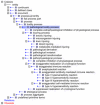Towards an ontological theory of substance intolerance and hypersensitivity
- PMID: 20152933
- PMCID: PMC2888796
- DOI: 10.1016/j.jbi.2010.02.003
Towards an ontological theory of substance intolerance and hypersensitivity
Abstract
A proper ontological treatment of intolerance--including hypersensitivity--to various substances is critical to patient care and research. However, existing methods and standards for documenting these conditions have flaws that inhibit these goals, especially translational research that bridges the two activities. In response, I outline a realist approach to the ontology of substance intolerance, including hypersensitivity conditions. I defend a view of these conditions as a subtype of disease. Specifically, a substance intolerance is a disease whose pathological process(es) are realized upon exposure to a quantity of substance of a particular type, and this quantity would normally not cause the realization of the pathological process(es). To develop this theory, it was necessary to build pieces of a theory of pathological processes. Overall, however, the framework of the Ontology for General Medical Science (which uses Basic Formal Ontology as its uppermost level) was a more-than-adequate foundation on which to build the theory.
Copyright © 2010 Elsevier Inc. All rights reserved.
Figures
References
-
- Saxon A, Diaz-Sanchez D, Zhang K. The allergic response in host defense. In: Rich R, Fleisher T, Shearer W, Kotzin B, Schroeder H, editors. Clinical immunology: Principles and practice. 2nd ed. Mosby; London: 2001.
-
- Gomes ER, Demoly P. Epidemiology of hypersensitivity drug reactions. Curr Opin Allergy Clin Immunol. 2005 Aug;5(4):309–16. - PubMed
-
- Ceusters W, Capolupo M, DeMoor G, Devlies J. Introducing realist ontology for the representation of adverse events; Proceedings of FOIS; IOS Press. 2008.
-
- Bates B, Hoekelman R. Interviewing and the health history. In: Bates B, editor. A guide to physical examination. Third ed. JB Lippincott Company; Philadelphia: 1983.
Publication types
MeSH terms
Grants and funding
LinkOut - more resources
Full Text Sources
Medical



